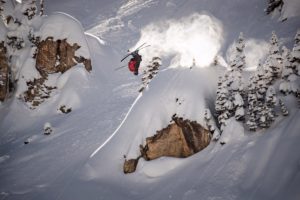To Huck or Not to Huck: Hucking vs. Dropping Cliffs
Humans like to jump off of stuff.
For millennia (it seems), people have been finding ever more creative ways to leap off of incredible heights into something soft that will arrest their landing and allow them to keep seeking that high-octane adrenaline rush. When did the first cavemen realize they could jump from a rock into a soft snowy landing? Kids—AKA small cavemen—that live in snowy landscapes wait until the snowpack builds up and jump from the roof. They seem to be onto something. It’s a satisfying and reassuring feeling, knowing that you’ll land with a flump and, yet, walk away unharmed.
Following this logic, it makes perfect sense why we also might want to do this same thing while skiing, and how so many mountains are esteemed for this very feature. Even if the rest of the mountain isn’t dotted with pillows, there are assured to be some excellent cornice drops.
Today, we are going to analyze the merits of jumping versus dropping. We will make the distinction here that dropping refers to “popping” off the top of something from a standing position, be it a cliff or cornice, versus hucking, which we define as moving with speed over the edge of a perfectly good bit of earth in the hopes of spending quality time in the air. It’s as a man once said—“You can’t get hurt in the air!”
Keep reading for the best in-bounds cliffs in the US
Dropping!
While it’s hard to argue that it takes more guts to drop off of a rock or cliff, as opposed to send it full-speed into the white abyss, there is also something to be said for staring down your target, choosing precisely not only where you want to land, but also where you need to land, in order to not end up with a sore everything, or worse.

photo credit MrAlDente, reddit
For this, you need to make sure you can “pop” off whatever it is you’re standing on. If the platform is too thin, or you’re still in the middle of catching your breath from the line above, be sure to take a couple extra breaths. The last thing you want to do is have half of your body go with the other half not exactly following. Doing so leaves you prone, and no one wants a rock in the kidneys.
Finally, you want to be sure that whatever you’re landing on is either steep enough, or deep enough to support your weight. A 25-foot drop feels like nothing if you’re falling into angled fluff, but it’s a day-ender if say, it’s a flat landing and the snow has settled.
Once you’ve made up your mind, the last thing to remember is to enjoy it! Part of the beauty of dropping is taking one’s self back to those younger days, of jumping off the roof. Whether or not you stick the landing, it’s always good to find yourself covered in snow. But stick the landing, dude.
Hucking!
It should be kind of clear that, yes, there is a bit more skill involved with jumping off things as opposed to dropping off them. It’s a classic case, too, of the known versus the unknown – for some of us, looking at a prospective landing can be freaky, whereas for others, it’s just like any other line down trees or moguls, just on different terrain.
While the constraints are roughly the same as for dropping, there is another consideration, and it’s a big one: if you’re coming at speed over something, you’re going to need time to slow down at some point. So consider that you’ll need a lot of space to truly huck it. Whereas dropping can be a contained practice, you’ll need and want to know that your landing is free of trees, stumps, and lost snowboarders. This, unless you’re a truly exceptional aerial acrobat, rules out steep glades. No matter how good you are, catching an edge in the woods and experiencing a near-miss tree kiss is the kind of stuff that makes you count your blessings.
So number one, make sure the landing is clean. Number two, make sure your approach speed is such that you clear anything lower. Try to keep your wait centered as you’re dropping, and it doesn’t hurt to lean back a bit in the landing.
Jumping opens the pathways to tricks, flips and all manner of crazy ways to announce your entrance. Dropping allows you to become one with gravity, using your ski/board tip as a sort of buoy, letting the back ends of the pillows stabilize your center of balance. But at the end of the day, either method is great, and if you’re not into it, you can always live vicariously through watching someone send it as you’re riding up the lift—if you’re lucky.
So where are the best drops in-bounds in the US?
Well, we’ll have to kill you if we tell you the real spots, but these areas here are instant classics:
1. Corbett’s Couloir – Jackson Hole, Wyoming
2. The Headwaters – Big Sky, Montana
3. The Ridge, etc. – Bridger Bowl, Montana
4. Northwoods – Vail, Colorado
For any occasion like this, you can find discounted lift tickets for plenty of mountains with opportunities for both here.
Featured Resorts

Killington Resort

Pico Mountain

Mammoth Mountain

Palisades Tahoe

Arapahoe Basin

Aspen Snowmass

Sugarloaf

Sunday River

Big Sky

